Abstract
IL-2 induces tumour regression in some patients with metastatic disease, but the dose of IL-2 is limited by severe toxicity. Agents that increase the expression of IL-2 receptors in the effector cells could be used to improve the effectiveness of IL-2 in mediating its anti-tumour effect. We have reported that haemin increased the expression of IL-2 receptors in human peripheral blood mononuclear cells (PBMC) and synergized with IL-2 in the induction of mitogenicity, cytotoxicity and cytokine production. We now report on haemin-induced immune stimulation and tumour regression in mice. Haemin-induced mitogenicity in mouse splenocytes was potentiated up to two-fold by IL-2. The combination of haemin and IL-2 was also effective in inducing cytotoxicity for natural killer (NK)-resistant target cells. Maximal induction of cytotoxicity was attained at an optimal concentration of haemin of 10 microM. Higher concentrations were less effective. Splenocytes isolated from mice that had been treated in vivo with haemin and IL-2 incorporated twice the amount of 3H-thymidine compared with splenocytes from mice treated with either haemin or IL-2 alone. Cytotoxicity of splenocytes for NK-resistant target cells was not increased following in vivo administration of haemin and IL-2 when fresh splenocytes were tested. Cytotoxicity was enhanced, however, up to five-fold following 48 h in vitro incubation with IL-2. Administration of haemin and IL-2 resulted in a significant decrease (40%) of established hepatic metastases in mice. Either IL-2 or haemin alone at the dose used were ineffective. The anti-tumour effect of haemin and IL-2 was enhanced (63% decrease in metastases) by administration of the thiol compound, N-acetylcysteine. Since haemin can safely be administered to patients, it may represent a new class of biologic response modifiers that could enhance IL-2-mediated anti-tumour effects.
Full text
PDF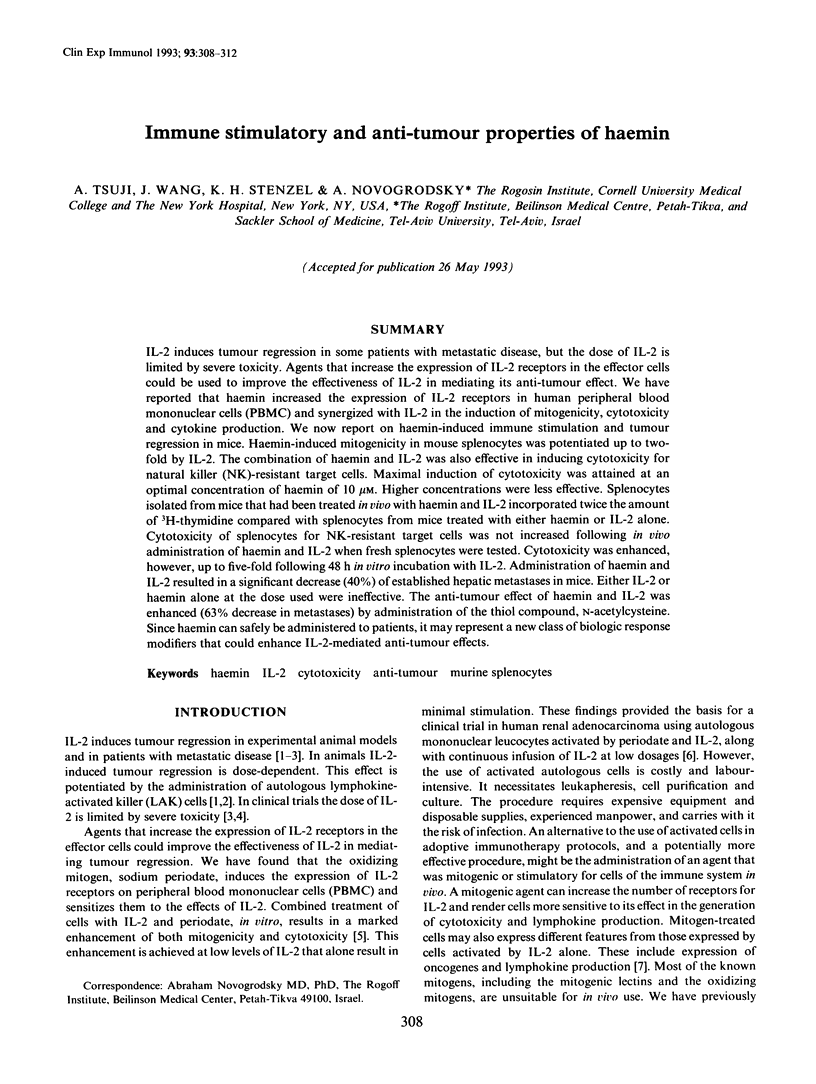
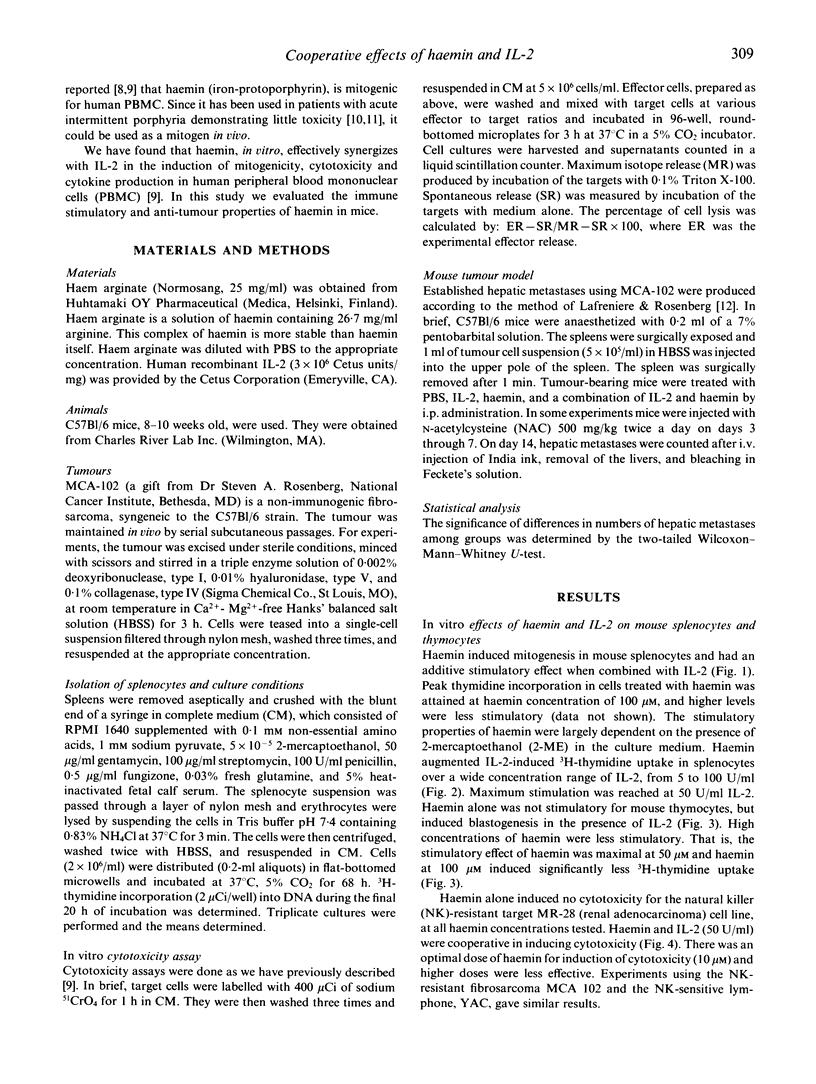
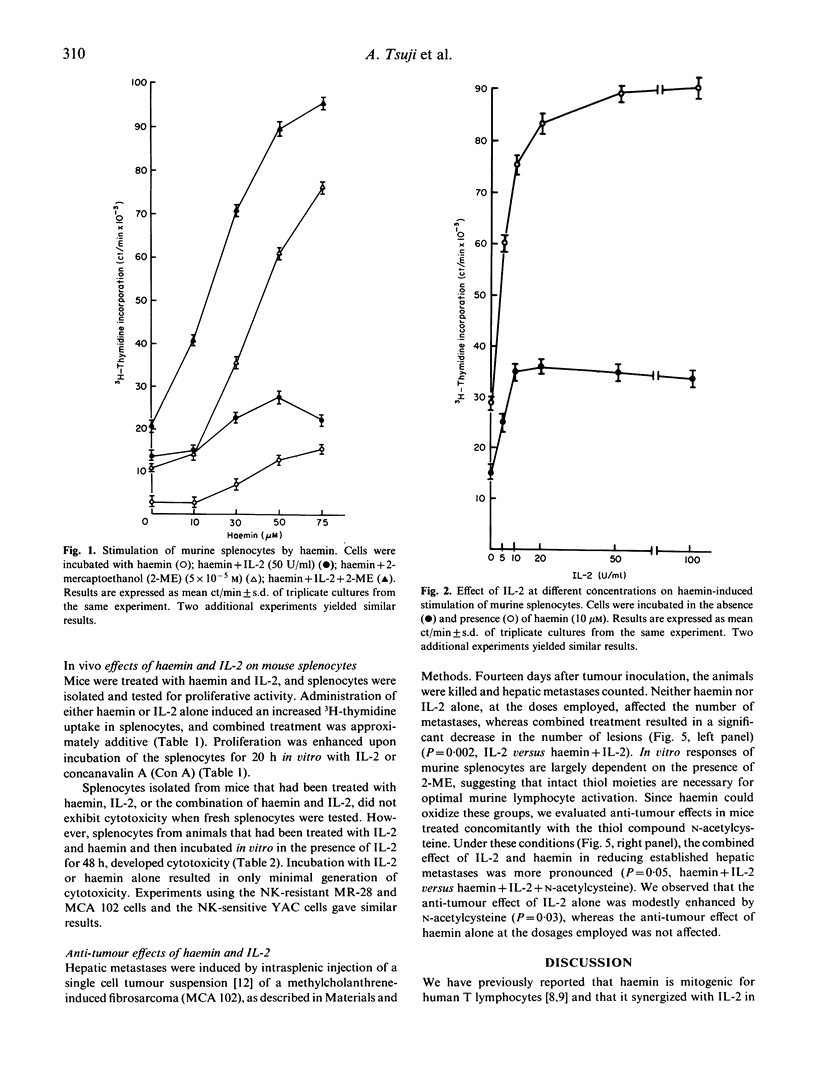
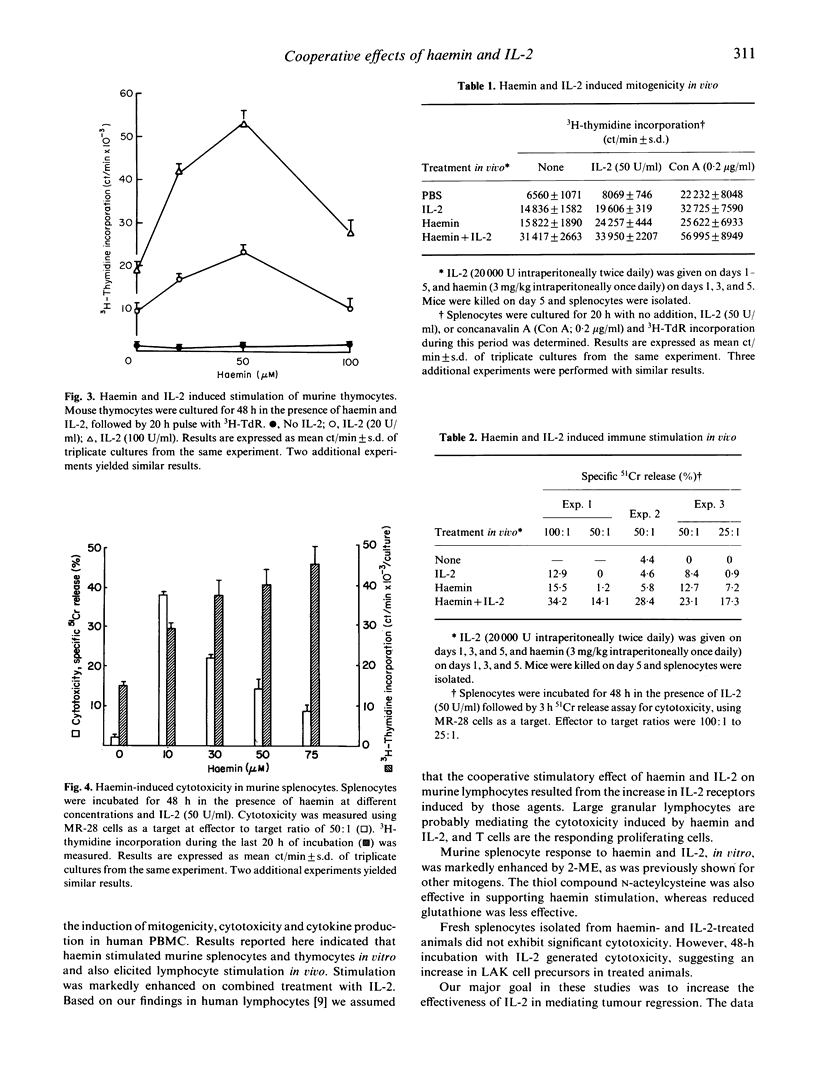
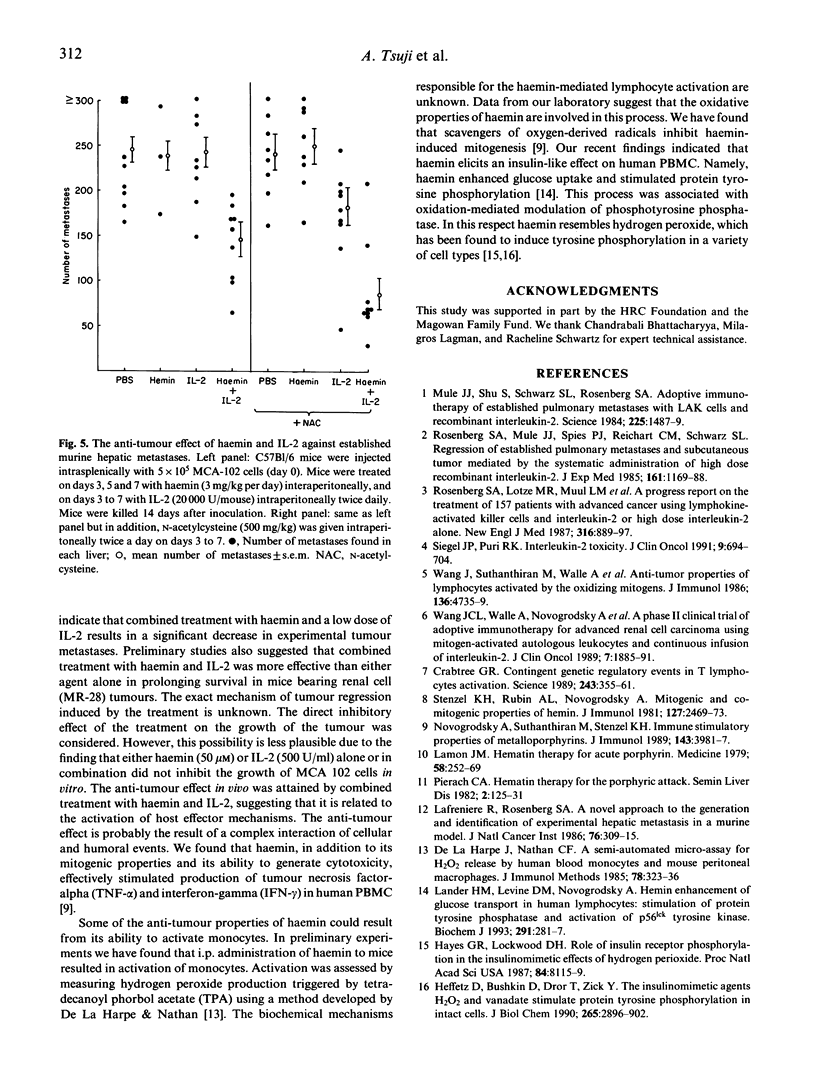
Selected References
These references are in PubMed. This may not be the complete list of references from this article.
- Crabtree G. R. Contingent genetic regulatory events in T lymphocyte activation. Science. 1989 Jan 20;243(4889):355–361. doi: 10.1126/science.2783497. [DOI] [PubMed] [Google Scholar]
- De la Harpe J., Nathan C. F. A semi-automated micro-assay for H2O2 release by human blood monocytes and mouse peritoneal macrophages. J Immunol Methods. 1985 Apr 22;78(2):323–336. doi: 10.1016/0022-1759(85)90089-4. [DOI] [PubMed] [Google Scholar]
- Hayes G. R., Lockwood D. H. Role of insulin receptor phosphorylation in the insulinomimetic effects of hydrogen peroxide. Proc Natl Acad Sci U S A. 1987 Nov;84(22):8115–8119. doi: 10.1073/pnas.84.22.8115. [DOI] [PMC free article] [PubMed] [Google Scholar]
- Heffetz D., Bushkin I., Dror R., Zick Y. The insulinomimetic agents H2O2 and vanadate stimulate protein tyrosine phosphorylation in intact cells. J Biol Chem. 1990 Feb 15;265(5):2896–2902. [PubMed] [Google Scholar]
- Lafreniere R., Rosenberg S. A. A novel approach to the generation and identification of experimental hepatic metastases in a murine model. J Natl Cancer Inst. 1986 Feb;76(2):309–322. [PubMed] [Google Scholar]
- Lamon J. M., Frykholm B. C., Hess R. A., Tschudy D. P. Hematin therapy for acute porphyria. Medicine (Baltimore) 1979 May;58(3):252–269. doi: 10.1097/00005792-197905000-00005. [DOI] [PubMed] [Google Scholar]
- Lander H. M., Levine D. M., Novogrodsky A. Haemin enhancement of glucose transport in human lymphocytes: stimulation of protein tyrosine phosphatase and activation of p56lck tyrosine kinase. Biochem J. 1993 Apr 1;291(Pt 1):281–287. doi: 10.1042/bj2910281. [DOI] [PMC free article] [PubMed] [Google Scholar]
- Mulé J. J., Shu S., Schwarz S. L., Rosenberg S. A. Adoptive immunotherapy of established pulmonary metastases with LAK cells and recombinant interleukin-2. Science. 1984 Sep 28;225(4669):1487–1489. doi: 10.1126/science.6332379. [DOI] [PubMed] [Google Scholar]
- Novogrodsky A., Suthanthiran M., Stenzel K. H. Immune stimulatory properties of metalloporphyrins. J Immunol. 1989 Dec 15;143(12):3981–3987. [PubMed] [Google Scholar]
- Pierach C. A. Hematin therapy for the porphyric attack. Semin Liver Dis. 1982 May;2(2):125–131. doi: 10.1055/s-2008-1040702. [DOI] [PubMed] [Google Scholar]
- Rosenberg S. A., Lotze M. T., Muul L. M., Chang A. E., Avis F. P., Leitman S., Linehan W. M., Robertson C. N., Lee R. E., Rubin J. T. A progress report on the treatment of 157 patients with advanced cancer using lymphokine-activated killer cells and interleukin-2 or high-dose interleukin-2 alone. N Engl J Med. 1987 Apr 9;316(15):889–897. doi: 10.1056/NEJM198704093161501. [DOI] [PubMed] [Google Scholar]
- Rosenberg S. A., Mulé J. J., Spiess P. J., Reichert C. M., Schwarz S. L. Regression of established pulmonary metastases and subcutaneous tumor mediated by the systemic administration of high-dose recombinant interleukin 2. J Exp Med. 1985 May 1;161(5):1169–1188. doi: 10.1084/jem.161.5.1169. [DOI] [PMC free article] [PubMed] [Google Scholar]
- Siegel J. P., Puri R. K. Interleukin-2 toxicity. J Clin Oncol. 1991 Apr;9(4):694–704. doi: 10.1200/JCO.1991.9.4.694. [DOI] [PubMed] [Google Scholar]
- Stenzel K. H., Rubin A. L., Novogrodsky A. Mitogenic and co-mitogenic properties of hemin. J Immunol. 1981 Dec;127(6):2469–2473. [PubMed] [Google Scholar]
- Wang J. C., Walle A., Novogrodsky A., Suthanthiran M., Silver R. T., Bander N. H., Rubin A. L., Stenzel K. H. A phase II clinical trial of adoptive immunotherapy for advanced renal cell carcinoma using mitogen-activated autologous leukocytes and continuous infusion interleukin-2. J Clin Oncol. 1989 Dec;7(12):1885–1891. doi: 10.1200/JCO.1989.7.12.1885. [DOI] [PubMed] [Google Scholar]
- Wang J., Suthanthiran M., Walle A., Lagman M., Schwartz R., Murthi V., Novogrodsky A., Stenzel K. H. Anti-tumor properties of lymphocytes activated by the oxidizing mitogens. J Immunol. 1986 Jun 15;136(12):4735–4739. [PubMed] [Google Scholar]


